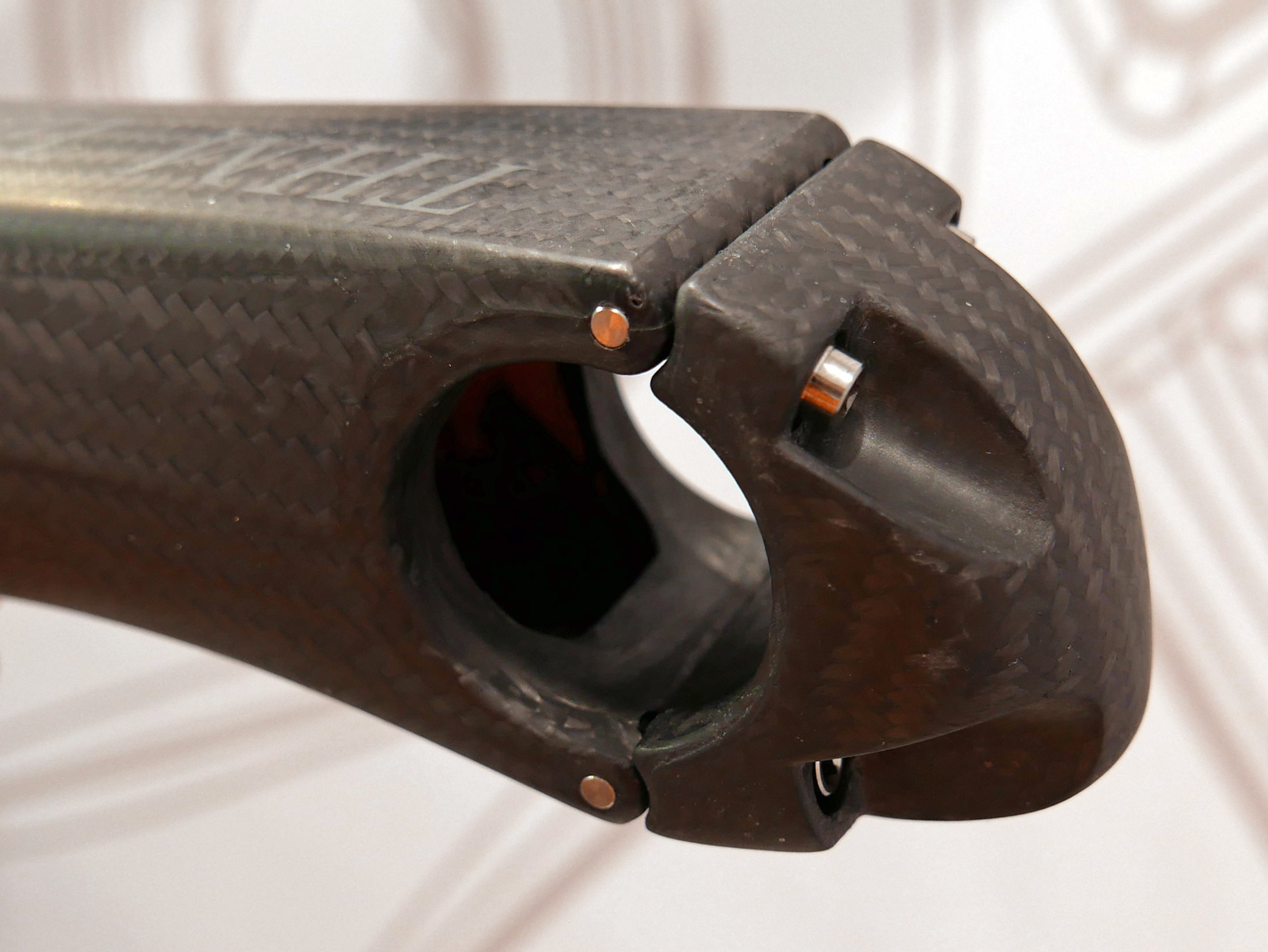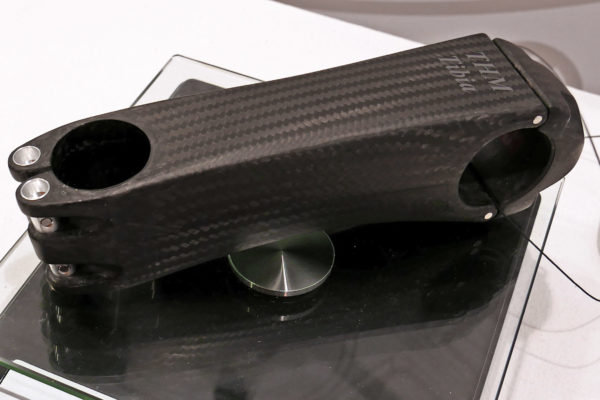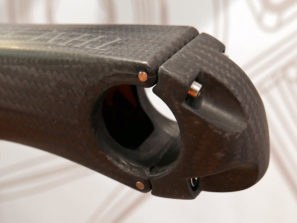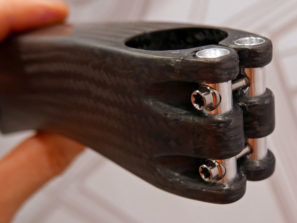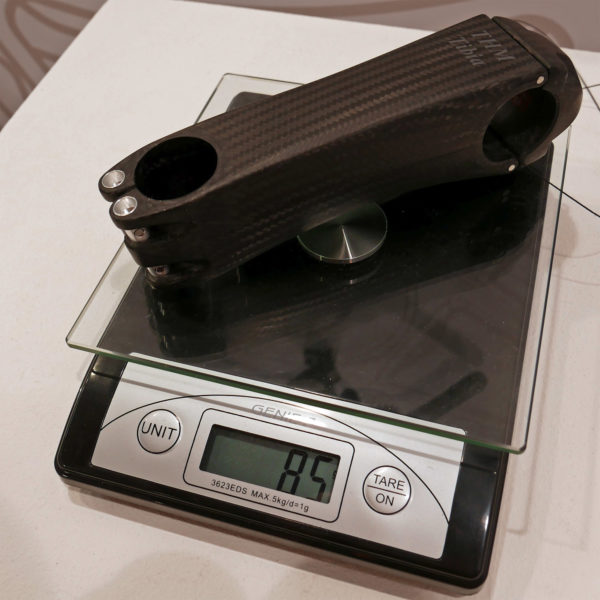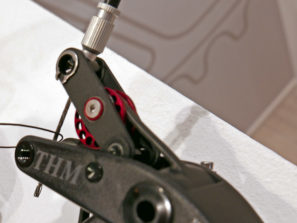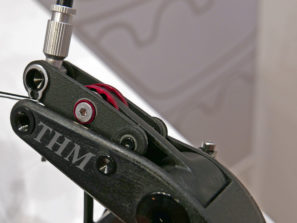THM is well known for producing some of the lightest carbon layups and most engineered carbon components that you are likely to find in any corner of the cycling industry. But what isn’t always so clear is how they come up with such new and innovative solutions for components that sometime they have been producing for more than a decade, and how they turn those new ideas into consumer products so quickly. Take a closer look at that <90g 120mm stem after the break, plus a new brake design that promises power and performance…
Tibia
Part of how THM develops their cutting edge of carbon fiber tech and component design is by partnering with university research teams. Both of these two new components for 2017 are innovative enough that the engineers leading both new solutions are developing them as part of their post-graduate materials science degrees.
For the new Tibia stem, even weight-obsessed THM admitted that they could have pushed even lighter. Even with weight as an obvious driving factor, THM puts a great importance on the actual design of a product. THM sees that stem as that humble, but critical connection from bike to bars. While often overlooked, their intention is to provide a light and stiff connection to link the two.
As from the bone that gives it its name, the Tibia has the dual purpose of providing a controlling link but also damping impacts. The Tibia itself was also designed to have a form inspired by nature, with a natural streamlined look to it. With that comes some innate aerodynamics.
Weight is of course never an afterthought in any product developed under the THM name. Here as part of a materials Masters thesis project, the Tibia was developed as ultimate lightweight solution to bolting your handlebar to the bike. And THM doesn’t disappoint on the light weight. Not many stems can make a claim to weighing just 85g, and the Tibia does just that in its longest 120mm offering.
The stem we had a chance to weigh was the 6th prototype of the Tibia. In fact, when we put the 3rd generation stem on the scale, we were quickly stopped. Apparently since that earlier generation the carbon layup and resin had been substantially refined to better optimize stiffness and weight, enough that they didn’t want us to weigh that stem. But the crazy part to us here was that stem weighed just 7g more. Sure, 7g doesn’t sound like much, but at this level that’s almost 10% that they had managed to shave off.
For now the Tibia is available exclusively in a 31.8mm bar clamp and 1.125″ stem clamp with 40mm of steerer stack. It comes in 80, 100, 110 & 120mm lengths (with the 100mm claimed to weigh just 78g) and in a +/- 6º configuration. The stem is finished in a polished carbon. That means that it uses a UV-stable resin, then gets buffed to a matte finish. No extra, heavy clearcoat required.
The stem is held together with titanium hardware, on both ends threaded into replaceable pins instead of any carbon threads. That eaves the carbon fibers continuous and unbroken for a part designed to stand up to the tests of time.
Fibula
The Fibula brakes were equal performers delivering performance at an unrivalled weight, even more than a decade after their first introduction. We aren’t showing them on our scale as the prototypes we saw were not yet production parts, but do show a new process using resin-transfer molding instead of individual pre-preg pieces layers into a mold. That said, THM has certainly lived up to their ultra light claims, so when they say that the brakes will come in at 120g for the pair (61g front/59g rear, without brake pads), who are we to doubt them?
The all carbon brakeset will feature not only fully carbon arms, but will use a carbon return spring as well. They do not include brake pads, but do come with a Shimano-style pad carrier for easy access and replacement of pads. The brakes use a 1:1.5 movement ratio that has been optimized to work well with Shimano, SRAM & Campy groupsets.
The big difference and key innovation in the new Fibula vs. its prior generation is that new red cam that lets them serve both wide and narrow rims. By moving the axle pivot point between two positions within the red alloy can the brakes can easily be positioned for either 19mm or 30mm wide rims. It even is said to clear up to a 33mm between the pads when they are fully open to allow the newest crop of fat tires up to 28mm wide to easily slide in and out. This isn’t a tool-free adjustment like you see on some brakes, but on a brakeset this light that is often used with a superlight cable/housing solution, it means that there is most likely no need to touch the cable fixing bolt, even when swapping between training and racing wheelsets.
Eliminating the prior linkage design, THM manages to add versatility without adding weight. Again that means some post-graduate research paper being written. The brakes get a combined bike+rider&gear weight limit of 110kg/243lb. Since the type of rider who is thinking about THM for their components isn’t likely to have a bike hit the UCI 6.8kg limit or haul around a lot of gear, that probably means that they are suitable for most any road cyclist.
This summer the THM brand was sold to 3T, and while sometimes such a sale can be seen as a start of a downward spiral, it really doesn’t look like the case here. As 3T was looking to expand into more advanced composites to develop their won aero carbon gravel bike frame, it’s pretty clear that the acquisition was to give them more technical carbon capability. The brain trust at THM remains strong. The entire team carries over, and is said to have maintained their engineering independence. Everyone that we knew at THM in the past is still there going strong, and if anything, it looks like they have really benefitted from the 3T buyout. They are continuing to work closely with young and creative materials engineers, and as it now looks like they have more resources at hand, plus a newfound outlet in gravel racing to apply their German carbon magic.
